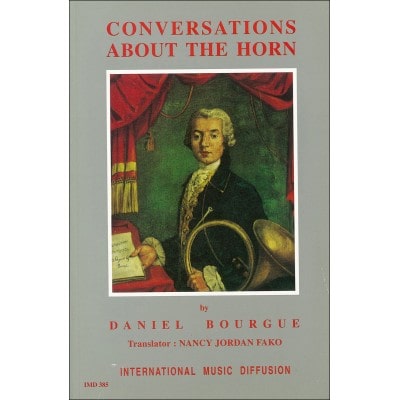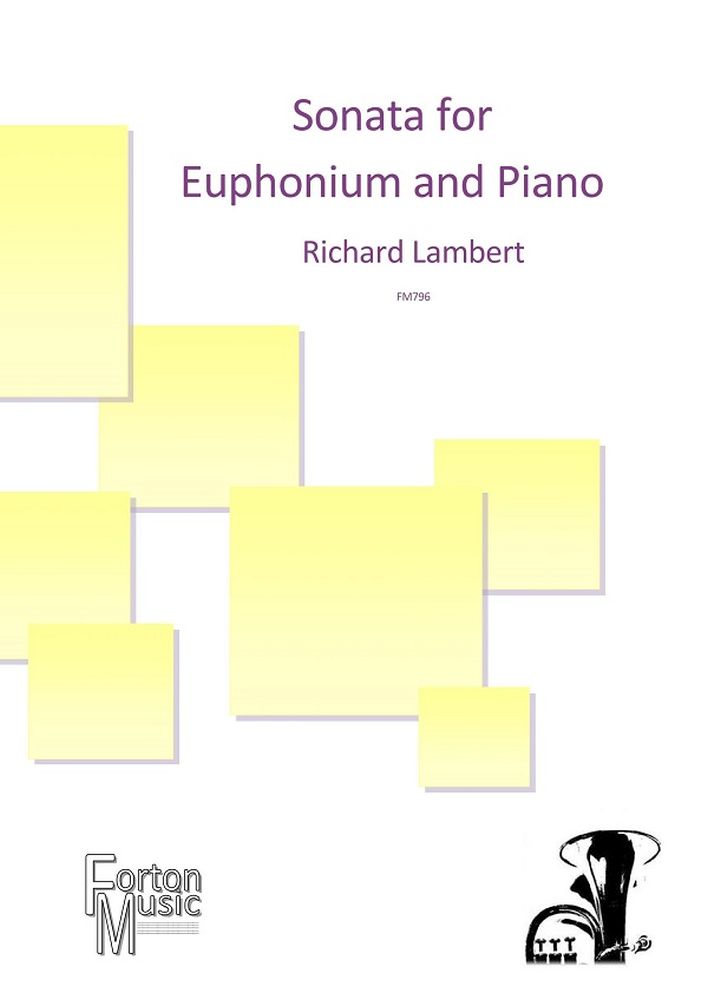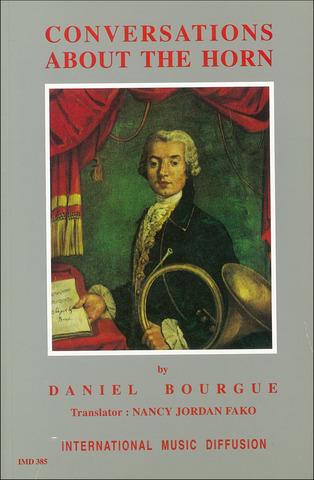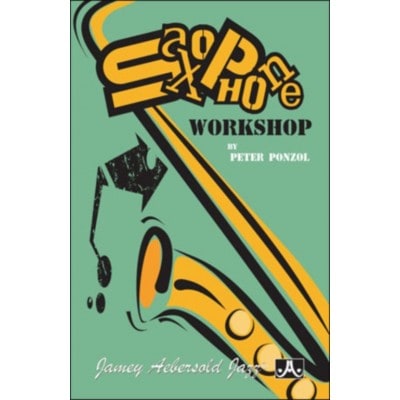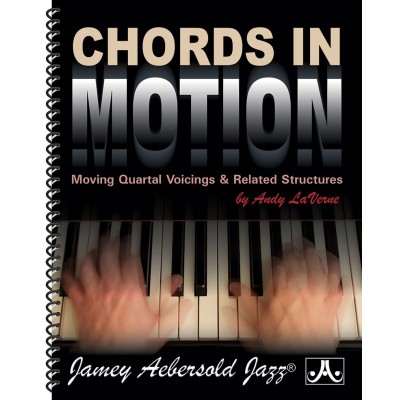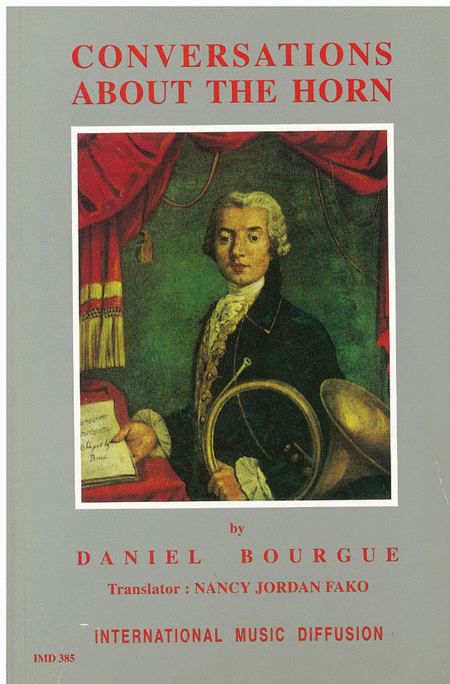|
| BOURGUE - CONVERSATIONS
ABOUT THE HORN - TRAITÉ
Imd Arpeges
BOURGUE - CONVERSATIONS ABOUT THE HORN - TRAITÉ / Cor / Imd Arpeges
Délais: Sur commande | | |
| Sonata (LAMBERT RICHARD)
Euphonium Ou Saxhorn Et Piano - Avancé
Forton Music
Par LAMBERT RICHARD. 3 movement sonata in a modern style The Sonata for euphoniu...(+)
Par LAMBERT RICHARD. 3 movement sonata in a modern style The Sonata for euphonium and piano was written in 2013, an idiomatic transcription of the Sonata for bassoon and piano (Op.36) Lasting about 13 minutes, it has three movements: Allegro Moderato - Larghetto - Allegretto con spirito. The first movement is free-ranging tonally, continually developing the initial thematic material - a neo-Baroque motif with prominent use of a minor seventh interval. The time signature is continually changing, predominantly between 2/4 and 3/8, to give a highly-charged rhythmic, and perhaps unsettled, effect. The central movement is expressive, melancholy and desolate. The rhythm is more regular here - largely a steady 6/8 flow, butharmonically, the highly chromatic style is almost atonal to enhance this forlorn atmosphere. The movement explores the entire range of the euphonium and the piano accompaniment converses contrapuntally, sharing the numerous motifs with the euphonium. It concludes plaintively with reiterations of the euphonium's initial four notes. The finale reverts to a more relaxed, and uplifting, mood. The euphonium's initial scalic motif also has a neo-Baroque flavour. This originates from a solitary piano figure (bar 202) in the first movement. In fact, these outer movements have numerous melodic and harmonic links to consolidate a sense of overall organic shape. Ultimately, the whole movement derives from its first few bars, and constantly develops this material. / Niveau : Avancé / Répertoire / Euphonium et Piano
Délais: 2-5 jours - En Stock Fournisseur | | |
| Conversations About The
Horn
Cor
IMD (International Music Diffusion)
31.90 EUR - vendu par LMI-partitions
Délais: 2-5 jours - En Stock Fournisseur | | |
| Ponzol Peter - Saxophone
Workshop - Pocket Guide
Saxophone
Jamey Aebersold Jazz
Imagine someone who has worked as an international saxophonist, an educator, a t...(+)
Imagine someone who has worked as an international saxophonist, an educator, a technician, a consultant, and as a designer, and you can imagine Peter Ponzol. For the first time, Peter offers details from his famous Saxophone Workshops. Learn about: ' Maintenance ' Reeds ' Mouthpieces ' Ligatures ' Sound ' Flexibility This exciting and informational pocket book will be a much needed addition to your musical library! Convenient pocket-sized book - 3.5 x 5.5 - perfect to toss in your gig bag! 64 pages. Peter has been around saxophones for decades, doing it all from manufacturing horns to reeds to mouthpieces. As well, he is a seasoned player. What he discusses in this book is coming from one of the sources-read carefully! - David Liebman, Sax artist/ author/ clinician. Read this review from Sax On The Web: The information in this book is right up SOTW's alley, with answers regarding reeds, necks, mouthpieces, saxes, maintenance, and the like. I would assume that the number of redundant threads started could be reduced almost in half simply with a reading of this book and those owning it could refer back to it at their leisure, as needed. And there is enough info in this book which contradicts some of our SOTW urban legends to make an episode of MythBusters. If you catch the right posts at the right time, much of the info in this book is already posted here on SOTW. But you have to see it and if hunting for it, you have to find it. OTOH it's all conveniently gathered and organized here in this primer - plus more. There are suggestions such as replacing the neck cork once or twice a year, which I would, if posting a response, say is not necessary. But here's the difference. Many of us on the forum are experienced musicians but few have the experience and depth that Ponzol has. We can write with credibility - Ponzol writes with authority. And this is based on decades not only as a top-echelon player, but as a successful and innovative sax, neck and mpc designer. The book is a 61 page pocket reference booklet which, in addition to topics mentioned above, include thoughts on ligatures, sound and flexibility. It is based on items of interest asked by attendees at workshops he has given over the years, hence the title. He begins by pointing out that at these workshops one of the first things he does is look at the condition of attendees' equipment with the observation that at least 90% of them need some kind of work and adjustments. What follows in the book's 61 pages are recommendations generated by this observation. Included are interesting comments such as: aging store-bought reeds by letting them sit for several years is fairly useless since the aging process stops once the bark has been cut away from the reed; not earth-shattering but interesting and certainly myth debunking. Again something that fits right in with many of the conversations on this forum. Interesting thoughts follow regarding the future of natural cane reeds, or how to select and get the most from your reeds - things I wouldn't think of like sanding the heel of your reed. SOTWers might also get a kick out of, and relate to, the title of his section on mouthpieces, 'Now the Fun Begins'. There are also interesting side comments we don't often hear like: in the 70s so many young players like Ponzol were trying to get Trane's recorded sound by working on metal Links because that's what they saw in photos and yet, Trane often recorded with hard rubber mpcs because, in Trane's opinion, it didn't have as much spit in the sound for him. It's interesting how some things come around back to you. There are two exercises I recommend to my students and have recommended on the forum regarding volume and embouchure control and flexibility. I've never heard anyone else recommend these exercises and yet here they are in Peter's book. Then it hit me. The only other one I know who uses them is a former teacher of mine and I remembered that years ago he said he had had some lessons with Ponzol. So 'the circle is unbroken' LOL. I would highly recommend it for beginners and intermediates, as well as for more advanced players to recommend to their students. It has made me re-think even some of my most basic assumptions regarding equipment and maintenance, which has made the read well worth it. I wish every SOTW newbie would start out their Forum time with this booklet at their disposal.
Délais: Sur commande | | |
| Laverne A. - Chords In
Motion - Piano
Piano seul
Jamey Aebersold Jazz
Noted jazz pianist, composer, recording artist and educator Andy LaVerne has dra...(+)
Noted jazz pianist, composer, recording artist and educator Andy LaVerne has drawn from his decades of experience playing with master musicians from Getz to Lovano to create this comprehensive compendium of contemporary moving voicings. Quartal, quintal, drop 2, dominant 7b9/diminished, triadic, whole tone and chromatic performance proven voicings pioneered by McCoy Tyner, Chick Corea, Herbie Hancock, and Andy himself are presented and fleshed out in all twelve keys. This book picks up where others leave off, enabling you to replace static chords with voicings that move melodically, dramatically, and gracefully over the entire range of the keyboard. Firmly rooted in contemporary jazz theory, the emphasis is on practical performance applications. Andy ties it all together with illustrations of comping choruses for five standard jazz tunes. Chords in Motion satisfies a long awaited need in actual comping situations, and shows you how to move chords through varying harmonic rhythms. FINALLY ' a book that gives you moving voicings, and sets them in motion in all twelve keys. Chords in Motion is a valuable resource for all keyboardists, arrangers, and instrumentalists. Activate, animate, and energize your comping with this encyclopedic volume. 156 pages, spiral bound for easy opening. Andy carries the flame of jazz piano tradition and just great music. He always inspires me. Chick Corea This is a great book! I am going to sit down and play through this!! I am always telling my non-piano playing students how important it is to work with (and internalize) the sounds that we live with all our lives as Jazz musicians. Coltrane spent years sitting at the piano and so should all of us!!! John Patitucci Berklee College of Music One thing about Andy'he is complete as can be and has been consistently so for years in both his teaching materials and playing. He is completely knowledgeable in such a way that when I play with him, I know he KNOWS!! Plus he is one of the smoothest and polished of players around. Great book'encyclopedic in content. Dave Liebman Founder, Artistic Director, International Association of Schools of Jazz (IASJ) I've played and recorded with Andy LaVerne many times over the years and in many different settings and he's always come up with the hippest, most interesting chords in the most musical way! His way of playing and looking at chords inspires me as a drummer and his rhythm section partner to play things that are in turn inspiring to the rest of the band. This book, helps musicians, understand, in a clear thoughtful presentation, how to go about getting this together. Billy Drummond Jazz Drummer, Educator, Juilliard, NYU Chords in Motion is an outstanding and comprehensive guide by Andy LaVerne, whose encyclopedic knowledge, decades of experience and brilliance as a performer and educator make this an invaluable handbook of modern jazz piano harmony. Its user-friendly, intelligent design enables musicians to expand their harmonic palette and potentially transform their playing, writing and arranging. Chords in Motion is an invaluable contribution to jazz musicians! Lynne Arriale Jazz Pianist, Composer, Educator, Associate Professor of Jazz Piano, Director of Small Ensembles, University of North Florida Chords in Motion is exactly the book I'd expect from Andy LaVerne. It's clear, openhearted and inspiring, as has been every conversation I've had with Andy over the years. Long a fan of his playing, I have enjoyed this look behind the curtain at how Andy LaVerne formulated his signature style. One other thing -- any pianist, no matter his/her approach, will gain insight into what will surely be new and exciting musical directions. Pete Malinverni Jazz Pianist, Educator, Director of Jazz Studies, SUNY Purchase College Conservatory of Music What a great resource for expanding the harmonic palette! Chords in Motion is a must have for the aspiring young jazz pianist as well as the seasoned veteran. Another winner from Andy! Paul Schmeling Jazz Pianist, Educator, Chair Emeritus, Piano Department, Berklee College of Music In Chords in Motion, I recognize chords and sounds that have inspired me to compose and play: harmony from the music of Chick Corea, Herbie Hancock and McCoy Tyner. This book is well organized, and from the beginning gets you playing. Each chord structure is explained and developed. There is plenty to practice. I especially like the exercises using contrary motion, arpeggiation and pivot, and the application to tunes. The reader will be tempted to stop on every page and compose. I found the Lost Chord, but won't tell you the page number. Bert Ligon Jazz Pianist/Guitarist, Composer, Arranger, Educator, Director of Jazz Studies, University of South Carolina Ever wonder how to move harmony around instead of repeating the same chord voicing over and over' Then Chords in Motion is a must have book for you! Andy has included a ton of information that will open up your comping and should keep you busy with new ideas for a long time! I highly recommend it! Dan Haerle Jazz Pianist, Composer, Author, Educator, Professor Emeritus, University of North Texas Chords in Motion is an essential guide to expanding one's conception of modern Jazz Piano Harmony. Andy LaVerne has managed to outline in a very practical and concise way, modern principles of piano chord voicings, as they pertain to the Jazz Pianist's primary group function of comping. David Hazeltine Jazz Pianist, Composer, Educator, SUNY Purchase College Conservatory of Music Chords in Motion should be fun to take into the practice room to explore new ways of sustaining harmonies over the entire register of the piano. It is encyclopedic and thorough in its content. No stone is left unturned! Stephany Tiernan Pianist, Composer, Educator, Chair, Piano Department, Berklee College Of Music Chords In Motion is an excellent practicing resource that provides a garden of harmonic sonorities for a musician to choose and explore at the piano. I like the way that Andy has made the information accessible to any level of student. I look forward to discovering some different sounds with this book. Phil DeGreg Jazz Pianist, Author, Educator, University of Cincinnati College Conservatory of Music I am delighted to recommend Andy LaVerne's Chords In Motion to aspiring jazz pianists! Andy is a superb pianist, very capable of addressing this topic. Prior to pianists like McCoy Tyner, Herbie Hancock, Bill Evans, and others, most pianists were content to have acquired a small handful of chord voicings, generally with the chord roots on the bottom of the voicings. Though 'rootless voicings' were adopted in later years, they were primarily for the left hand and generally only used the 3rd or 7th on the bottom. But now the serious jazz pianist needs to be able to move his or her voicings in a more diatonic manner, as shown in Andy's book. Jerry Coker Jazz Saxophonist, Author, Educator Andy LaVerne's Chords in Motion is a study of encyclopedic scope on the use of harmonies based on fourth intervals in the context of jazz harmony. There is a wealth of information in terms of voicings, voice leading and chord/scale relationships and their application to common harmonic formulae (ii-V, etc.) and the chord progressions used in blues and common standard tunes. Jazz musicians interested in this vocabulary should find this book to be a useful launching pad for exploring this important corner of the world of jazz harmony. Bill Dobbins Jazz Pianist, Composer, Arranger, Author, Educator, Professor of Jazz Studies, Conductor, Coordinator Jazz Composition and Arranging, Eastman School of Music Chords in Motion is a highly detailed, informative and filling-in-the-gap text. It's an important and welcome addition to the jazz piano literature, which can be applied to any level of proficiency. Stefan Karlsson Jazz Pianist, Educator, Professor/Jazz Studies Division, University of North Texas Fantastic pianist Andy LaVerne has put together an amazing, detailed, and incredibly comprehensive guide for effectively implementing quartal and related voicings. He has honed in on the 'secret' to using these structures musically and creatively: moving the voicings through changes in logical and interesting ways. Clearly presented, extremely thorough, and loaded with information, Chords in Motion is a must-have for any pianist! Martin Bejerano Jazz Pianist, Composer, Educator, Assistant Professor, Jazz Piano, Frost School of Music University of Miami Chords in Motion is an in-depth look at fourth and related voicings that give an atmosphere that you want to improvise on. We play over the voicing, not the chord symbol. Chords in Motion targets that modal atmosphere that horn players love playing over. Love this book - can't wait to start practicing it! Jerry Bergonzi Jazz Saxophonist, Composer, Author, Educator, New England Conservatory I was thrilled when Jazz Piano Great Mulgrew Miller agreed to write a quote for this book. I was deeply saddened to hear of Mulgrew's passing just days before publication. All who loved Mulgrew and his music will sorely miss him, and are grateful for the rich musical legacy he left us. Rest easy, Mulgrew. Andy LaVerne
Délais: Sur commande | |
|
|
|
| Conversations about the horn
Cor
International Music Diffusion
By D. Bourgue. Arranged by N.J. Fako. For horn. Traites. Published by Internatio...(+)
By D. Bourgue. Arranged
by N.J. Fako. For horn.
Traites. Published by
International Music
Diffusion (Arpeges
Diffusion) (French
import).
$32.95 - Voir plus => AcheterDélais: 4 to 6 weeks | | | |
| Itallegro
Breitkopf & Härtel
SKU: BR.BV-480 Italian Terms from A-Z in Music and Everyday Life - Glo...(+)
SKU: BR.BV-480
Italian Terms from A-Z
in Music and Everyday
Life - Glossary,
Conversational Anecdotes
and Asides |.
Composed by Jutta Eckes.
Hardback. Buchverlag
Breitkopf & Hartel (Music
Books). Music pedagogy.
Book. 122 pages.
Breitkopf and Haertel #BV
480. Published by
Breitkopf and Haertel
(BR.BV-480). ISBN
9783765104800. 8.5 x 8.5
inches.
German. Allegro,
adagio, piano, crescendo
... No one dealing with
music - laypeople or
professionals - can avoid
Italian. ITALLEGRO lists,
translates, explains, and
supplements some 400
Italian musical terms. It
aims to broaden the view
of the language in an
entertaining way and to
arouse interest in
Italian, such as, for
example, in the origin of
a word or its use in
everyday language. Lots
of terms give rise to
surprising insights.
Storielle relates little
stories about one or the
other musical concept.
You'll read, for example,
about Handel's famous
Largo, or why caution
should be exercised in
using the Italian word
for horn. In the
Vetrinette = little show
window, information about
various topics shows up
at a glance: What are
notes and intervals
called in Italian or
Italian operas in German,
for instance?
Pronunciation is also not
neglected: The most
important rules you'll
find in the book, and the
vast majority of words,
you'll hear spoken here
for
download.
Allegro,
adagio, piano, crescendo
… No one dealing
with music - laypeople or
professionals - can avoid
Italian. ITALLEGRO lists,
translates, explains, and
supplements some 400
Italian musical
terms. $37.95 - Voir plus => AcheterDélais: 3 to 4 weeks | | |
|
|
